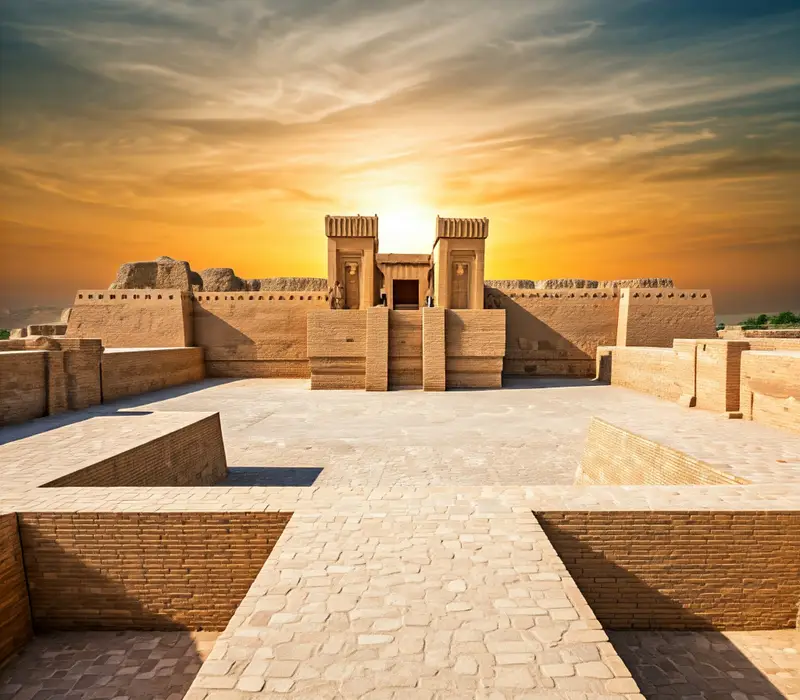History of the city of Dur-Sharrukin

Dur-Sharrukin
Dur-Sharrukin, meaning “Fortress of Sargon,” was a grand city and capital of the Assyrian Empire during the reign of King Sargon II. Located at Khorsabad, a village approximately 15 km north of modern-day Mosul in Iraq, Dur-Sharrukin was envisioned as a showcase of Assyrian strength and culture. The city was completed in 706 BCE, shortly before the death of Sargon II, who had ordered its construction over a decade earlier in 717 BCE. Positioned strategically at the confluence of the Tigris and Greater Zab rivers, the city served as an impressive example of Assyrian architectural prowess and political ambition.
The History of Dur-Sharrukin’s Construction
In 717 BCE, Sargon II initiated the construction of Dur-Sharrukin to serve as his royal seat and as a powerful symbol of his empire. The construction materials, including timber and other resources, were imported from the Phoenician coast, while skilled artisans and craftsmen were brought from across the region. Assyrian records indicate that the debts of laborers were canceled to attract a large and skilled workforce. Furthermore, the fertile lands surrounding Dur-Sharrukin were cultivated extensively, with olive groves established to ensure a steady supply of olive oil for the kingdom.
By early 706 BCE, Dur-Sharrukin was complete, and the royal court relocated to the newly built city. However, the untimely death of Sargon II in 705 BCE on the battlefield marked a turning point. His son, Sennacherib, chose to abandon Dur-Sharrukin, preferring Nineveh as the new capital. As a result, the city gradually lost its significance and was ultimately deserted following the fall of the Neo-Assyrian Empire.
Architectural Features of Dur-Sharrukin
Dur-Sharrukin’s layout is square, measuring approximately 1,635 by 1,758 meters, and is surrounded by massive fortified walls. The outer wall, designed for maximum security, features 157 towers and seven main gates that provided access from all directions. Within these walls lay majestic temples and the grand royal palace, along with several smaller structures dedicated to Assyrian deities.
Temples and Religious Structures
The primary temples of Dur-Sharrukin were dedicated to the gods Nabu, Shamash, and Sin. Each of these deities held important roles within Assyrian spirituality, symbolizing knowledge, the sun, and the moon, respectively. The city also included smaller shrines devoted to Adad, Nergal, and Ninurta, as well as a prominent ziggurat temple—a sacred tower used for religious ceremonies.
The Royal Palace and Winged Bull Statues
The royal palace of Dur-Sharrukin was adorned with intricate carvings, sculptures, and murals that celebrated Assyrian victories and cultural achievements. One of the most notable elements of the palace’s design was the use of winged bull statues, known as Lamassu, which were placed at the entrances for protection. Weighing up to 40 tons each, these statues symbolized strength, wisdom, and protection, blending human and animal features in a uniquely Assyrian style.
The Royal Gardens and Hunting Park
Beyond its religious and administrative structures, Dur-Sharrukin also included a royal hunting park and an elaborate botanical garden. Sargon II’s royal gardens were cultivated with aromatic plants and fruit trees transported from Anatolia. Ancient inscriptions indicate that thousands of young fruit trees, including apple, quince, and almond, were brought to Dur-Sharrukin. An inscription from Sargon’s central garden speaks of the city’s artificial terraces and a man-made hill, which he referred to as the “Great Creation Terrace,” overlooking the Tigris River.
Archaeological Discoveries at Dur-Sharrukin
The ruins of Dur-Sharrukin have yielded valuable artifacts and insights into Assyrian life and governance. Excavations have revealed inscriptions detailing the construction process, records of daily life, and artwork showcasing the artistic sophistication of the Assyrians. The city’s defensive structures, temple ruins, and elaborate sculptures offer a vivid picture of the grandeur of ancient Assyrian civilization.